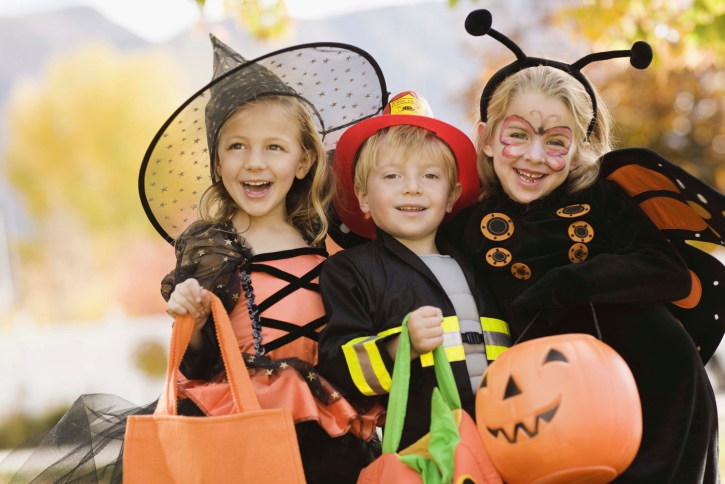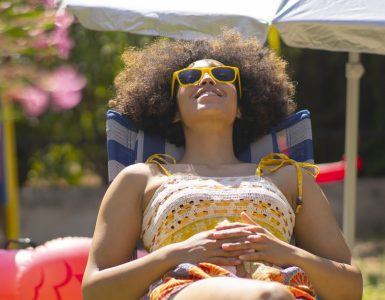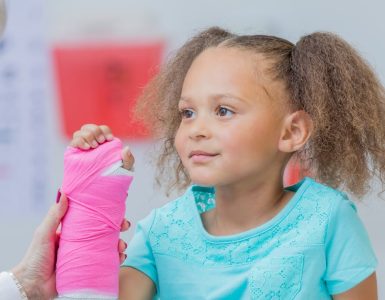Help your kids get the maximum enjoyment out of Halloween and trick-or-treating by making sure they stay safe. Halloween will be significantly less fun for the kids if there are bumps, bruises, scrapes, cuts, or allergies involved. Read on for a comprehensive list of tips you can use to help your little ghouls and goblins have a safer Halloween.
General safety
- Nobody should trick-or-treat alone. Ideally, one or more trusted, responsible adults should accompany a child, or group of children, as they trick-or-treat.
- Some trick-or-treaters may be old enough that parents feel comfortable allowing them to go out on their own, sans parents If that’s the case, tell your children that it’s important that they stay together while trick-or-treating. Parents should also know the route their kids will be taking while haunting the streets in search of candy. If you or another parent are not accompanying the children, you may want to consider giving them a cell phone and having them call to check in at predetermined times.
- Many towns have curfews on Halloween. Make sure you are aware of what your town’s curfew is so that you and/or your children don’t violate it.
- Remind your kids to not enter houses of people they don’t know, don’t talk to strangers, and that they should never get into a stranger’s car no matter what that person might offer them.
- Tell kids to walk on sidewalks and to avoid walking in people’s yards–there could be wires or ornaments that may pose a tripping hazard to your children. Encourage kids to stay in well-lit and well-populated areas and not go tromping off through fields, back alleys, or other shortcuts.
Costume safety
- Make sure your child can see clearly out of any mask they’re wearing.
- Attach reflector strips to your child’s costume for better visibility at night. Also consider incorporating a glow stick and/or flashlight into their costume.
- If your child’s costume involves makeup, do a patch test a few days before Halloween to test for any skin reactions like contact dermatitis. Hypo-allergenic makeup is the best kind to use–and no matter what kind of makeup you use, make sure to promptly wash it off your child after he comes home from trick-or-treating Children who are prone to eczema should avoid wearing greasy face paints.
- If your child is asthmatic, make sure their costume has a deep pocket or involves a little bag in which they can keep a rescue inhaler. Being out in the cold air and running between houses can trigger asthma.
- Make sure there are no allergens lurking in your child’s costume. If your child is sensitive to latex, make sure there’s no latex in their costume. If your child is sensitive to metals like nickel, ensure that there is no nickel in the details of their costume–it may be hiding in things like snaps, belt buckles, tiaras, and costume jewelry.
Treat-related safety
- Do not let your child eat any treats from his trick-or-treating endeavors until you have examined those treats to ensure that they’re safe.
- Bring a stash of safe treats–things that you have personally bought or made–along during trick-or-treating in case a child gets tempted and needs something to munch on.
- Discard any treats that are not sealed and/or are badly damaged. Avoid eating homemade treats made by strangers.
- Take precautions if your child has allergies. Note that some “fun size” versions of candies have slightly different ingredients than their full-size versions. Always read the label on the treat to see what it contains; if the label doesn’t list ingredients, go online to research it before letting your child eat it. Or, trade your child some safe treats, things you know for sure they can eat without an allergic reaction, in exchange for the treats you’re not sure are safe for them to eat.
- If your child has allergies, carry antihistamines or an auto-injector of epinephrine with you while trick-or-treating in case your child comes into contact with a food that triggers an allergic reaction.
For more Halloween safety tips, visit Halloween-Safety.com. Health Advocate wishes you and your family a safe, happy and healthy Halloween!



